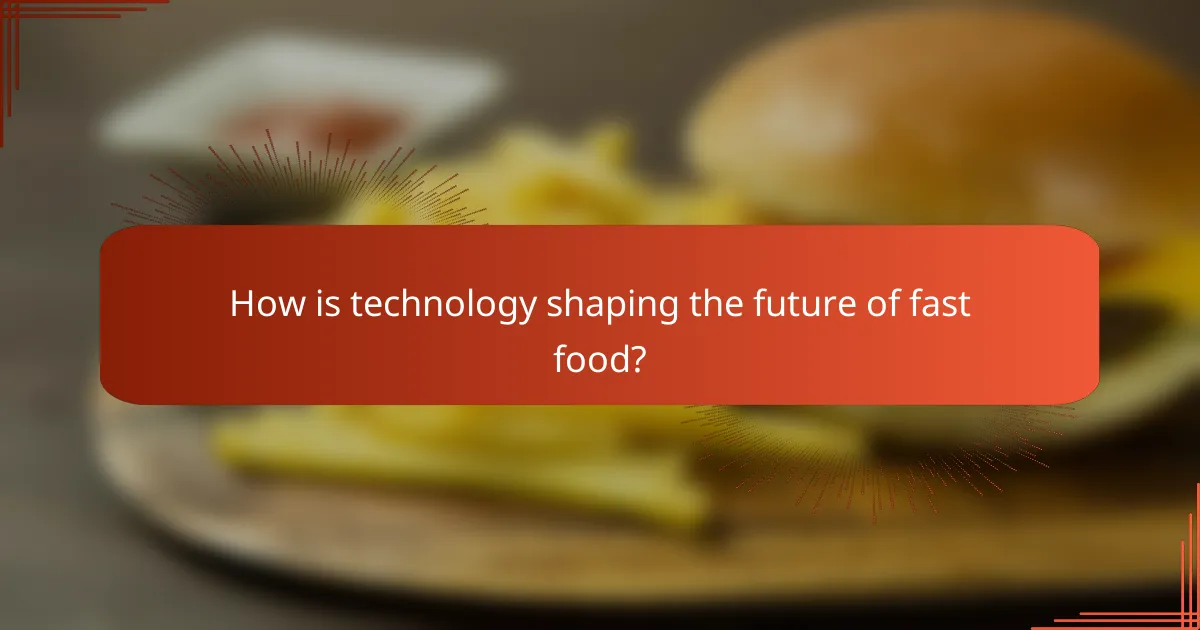The future of fast food is poised for significant transformation as technology integrates into every facet of the industry, enhancing efficiency and customer engagement. With a growing emphasis on health, sustainability, and convenience, consumer behavior is shifting towards more informed choices, prompting fast food chains to diversify their offerings and adopt innovative marketing strategies. As brands embrace automation and personalized services, they are better positioned to meet the evolving demands of today’s consumers.

How is technology shaping the future of fast food?
Technology is significantly transforming the fast food industry by streamlining operations, enhancing customer experience, and improving efficiency. Innovations such as AI, mobile apps, and automation are reshaping how consumers interact with fast food brands and how these brands deliver their services.
AI-driven ordering systems
AI-driven ordering systems utilize machine learning algorithms to personalize the customer experience. These systems analyze past orders and preferences to suggest menu items, reducing decision fatigue for customers and increasing average order value for restaurants.
Fast food chains can implement AI chatbots for taking orders through voice or text, which can handle multiple customers simultaneously, improving service speed. However, businesses should ensure that these systems are user-friendly to avoid frustrating customers.
Mobile app integrations
Mobile app integrations allow customers to place orders, customize meals, and make payments directly from their smartphones. These apps often include loyalty programs, enabling users to earn rewards and discounts, which can drive repeat business.
Fast food brands should focus on creating intuitive interfaces and seamless payment processes to enhance user satisfaction. Regular updates and customer feedback can help maintain app performance and relevance.
Automated kitchens
Automated kitchens employ robotics and smart technology to prepare food with minimal human intervention. This can lead to faster service times and consistent food quality, as machines can replicate recipes precisely.
While the initial investment in automation can be high, the long-term savings on labor costs and increased efficiency can make it worthwhile. Restaurants should consider starting with specific tasks, like frying or assembling, before fully automating their kitchens.
Delivery drones
Delivery drones are emerging as a novel solution for fast food delivery, promising to reduce delivery times and operational costs. These drones can navigate urban environments, delivering food directly to customers’ doorsteps in a matter of minutes.
However, regulatory hurdles and safety concerns must be addressed before widespread adoption. Fast food businesses should stay informed about local regulations regarding drone deliveries and consider pilot programs to test feasibility.
Contactless payment solutions
Contactless payment solutions enhance the speed and safety of transactions in fast food establishments. Technologies like NFC (Near Field Communication) allow customers to pay by simply tapping their cards or smartphones, minimizing physical contact.
Fast food chains should adopt these systems to meet growing consumer demand for convenience and hygiene. Ensuring compatibility with various payment methods, including digital wallets, can further enhance customer satisfaction and loyalty.

What are the key consumer behavior trends in fast food?
Key consumer behavior trends in fast food reflect a growing emphasis on health, sustainability, and convenience. As consumers become more informed, their preferences are shifting towards healthier options, transparency in sourcing, and quick service.
Health-conscious choices
Health-conscious choices are increasingly influencing fast food menus as consumers seek meals that align with their dietary goals. Many fast food chains are introducing lower-calorie options, meals with reduced sodium, and items rich in nutrients. For example, salads, grain bowls, and grilled proteins are becoming staples.
To cater to this trend, restaurants often highlight nutritional information on menus, allowing customers to make informed decisions. Offering customizable options can also help meet individual health preferences.
Preference for plant-based options
There is a notable preference for plant-based options among consumers, driven by health, environmental concerns, and ethical considerations. Fast food chains are responding by expanding their menus to include plant-based burgers, wraps, and sides, appealing to both vegetarians and flexitarians.
Brands like Beyond Meat and Impossible Foods have partnered with major chains to provide meat alternatives that mimic traditional flavors. This shift not only attracts a broader customer base but also addresses sustainability issues linked to meat production.
Demand for transparency in sourcing
Consumers are increasingly demanding transparency in sourcing, wanting to know where their food comes from and how it is produced. This trend is prompting fast food companies to disclose information about their ingredients, including sourcing practices and nutritional content.
Many brands are now emphasizing local sourcing, organic ingredients, and humane treatment of animals. Clear labeling and storytelling about sourcing can enhance consumer trust and loyalty.
Increased focus on convenience
Convenience remains a top priority for fast food consumers, with many seeking quick and easy meal solutions. The rise of mobile ordering, delivery apps, and drive-thru services reflects this demand for efficiency.
Fast food chains are investing in technology to streamline operations, such as self-service kiosks and advanced order management systems. Offering flexible pickup options and delivery partnerships can further enhance customer satisfaction.

How are fast food chains adapting to changing consumer preferences?
Fast food chains are increasingly responding to evolving consumer preferences by diversifying their menus, employing personalized marketing strategies, and forming partnerships with food delivery services. These adaptations help meet the growing demand for healthier options, convenience, and tailored customer experiences.
Menu diversification
Menu diversification involves expanding offerings to include healthier, plant-based, and globally inspired options. Many chains are introducing items that cater to dietary restrictions, such as gluten-free or vegan meals, to attract a broader customer base.
For instance, some fast food restaurants now feature salads, grain bowls, and fruit smoothies alongside traditional burgers and fries. This shift not only appeals to health-conscious consumers but also aligns with trends toward sustainability and ethical eating.
Personalized marketing strategies
Personalized marketing strategies leverage data analytics to tailor promotions and menu suggestions to individual preferences. Fast food brands are utilizing customer data from loyalty programs and mobile apps to create targeted advertisements that resonate with specific demographics.
For example, a customer who frequently orders vegetarian items may receive promotions for new plant-based menu options. This approach enhances customer engagement and increases the likelihood of repeat visits, as consumers feel their preferences are acknowledged and valued.
Partnerships with food delivery services
Partnerships with food delivery services have become essential for fast food chains, especially as consumer demand for convenience grows. Collaborations with platforms like Uber Eats, DoorDash, and Grubhub allow restaurants to reach customers who prefer dining at home.
These partnerships often include promotional deals, such as discounts on first-time orders or free delivery on minimum purchases. By integrating delivery options, fast food chains can significantly expand their market reach and cater to the changing habits of consumers who prioritize convenience.

What role does sustainability play in the future of fast food?
Sustainability is becoming a central focus for the fast food industry as consumers increasingly demand environmentally responsible practices. This shift includes reducing waste, using eco-friendly materials, and sourcing ingredients locally to minimize carbon footprints.
Eco-friendly packaging initiatives
Fast food chains are adopting eco-friendly packaging to address environmental concerns. This includes using biodegradable materials, compostable containers, and recyclable packaging to reduce plastic waste. For example, some companies are transitioning to plant-based materials that decompose more easily than traditional plastics.
Implementing these initiatives often requires investment in new materials and supplier relationships. However, the long-term benefits include enhanced brand loyalty among environmentally conscious consumers and potential cost savings from reduced waste disposal fees.
Waste reduction programs
Waste reduction programs are essential for minimizing the environmental impact of fast food operations. Many restaurants are now implementing strategies such as food donation programs, where surplus food is given to local shelters, and composting organic waste to divert it from landfills.
These programs not only help reduce waste but can also improve a restaurant’s public image and customer satisfaction. Establishing partnerships with local charities and waste management companies can streamline these efforts and ensure compliance with local regulations.
Local sourcing practices
Local sourcing practices involve purchasing ingredients from nearby farms and suppliers, which supports local economies and reduces transportation emissions. Fast food chains are increasingly highlighting local ingredients on their menus, appealing to consumers who prioritize fresh and sustainable options.
To effectively implement local sourcing, restaurants should establish relationships with local farmers and suppliers, ensuring a consistent supply of quality ingredients. Additionally, promoting these practices can enhance marketing efforts, as consumers often favor businesses that contribute to their communities.

How are fast food brands leveraging data analytics?
Fast food brands are increasingly using data analytics to enhance their operations, improve customer experiences, and optimize marketing strategies. By analyzing customer data, sales trends, and operational metrics, these brands can make informed decisions that drive profitability and customer satisfaction.
Customer behavior insights
Data analytics provides fast food brands with valuable insights into customer behavior, allowing them to understand preferences and purchasing patterns. For instance, analyzing transaction data can reveal peak hours, popular menu items, and customer demographics, which can inform menu design and promotional strategies.
Brands can utilize tools like customer surveys and loyalty programs to gather additional data, enabling them to tailor their offerings to specific segments. This targeted approach can lead to increased customer loyalty and higher sales, as customers feel their preferences are being recognized and catered to.
To effectively leverage customer behavior insights, fast food brands should regularly review and update their analytics strategies. This includes monitoring changes in consumer preferences and adapting marketing campaigns accordingly to maintain relevance in a competitive market.



